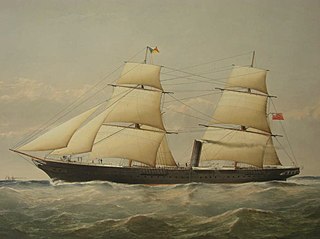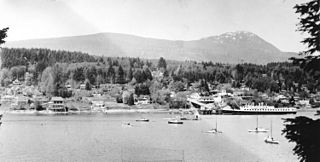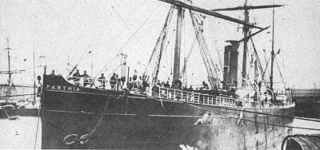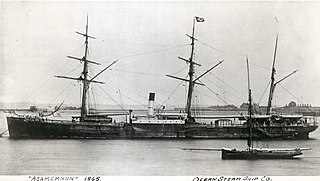
A steamship, often referred to as a steamer, is a type of steam-powered vessel, typically ocean-faring and seaworthy, that is propelled by one or more steam engines that typically move (turn) propellers or paddlewheels. The first steamships came into practical usage during the early 1800s; however, there were exceptions that came before. Steamships usually use the prefix designations of "PS" for paddle steamer or "SS" for screw steamer. As paddle steamers became less common, "SS" is assumed by many to stand for "steamship". Ships powered by internal combustion engines use a prefix such as "MV" for motor vessel, so it is not correct to use "SS" for most modern vessels.

SS Carnatic was a British steamship built in 1862-63 by Samuda Brothers at Cubitt Town on the Isle of Dogs, London, for the Peninsular and Oriental Steam Navigation Company (P&O). She operated on the Suez to Bombay run in the last years before the Suez Canal was opened. This route gave a fast, steamship-operated route from Britain to India, connecting with similar steamships running through the Mediterranean to Alexandria, with an overland crossing to Suez. The alternative was to sail round the Cape of Good Hope, a distance at which steam ships were not, in the early 1860s, sufficiently economical to be commercially competitive with sail.

A steamboat is a boat that is propelled primarily by steam power, typically driving propellers or paddlewheels. Steamboats sometimes use the prefix designation SS, S.S. or S/S or PS ; however, these designations are most often used for steamships.

A compound steam engine unit is a type of steam engine where steam is expanded in two or more stages. A typical arrangement for a compound engine is that the steam is first expanded in a high-pressure (HP) cylinder, then having given up heat and losing pressure, it exhausts directly into one or more larger-volume low-pressure (LP) cylinders. Multiple-expansion engines employ additional cylinders, of progressively lower pressure, to extract further energy from the steam.

The MV Cartela is an excursion vessel operating on the Derwent River in Hobart, Tasmania, Australia. She is now Australia's oldest continuously-licensed passenger vessel, although there are several older vessels still in service that have been restored after lengthy periods in dereliction.

Lucania was a British ocean liner owned by the Cunard Steamship Line Shipping Company, built by Fairfield Shipbuilding and Engineering Company of Govan, Scotland, and launched on Thursday, 2 February 1893.

HMS Swindon was a Hunt-class minesweeper of the Aberdare sub-class built for the Royal Navy during World War I. She was not finished in time to participate in the First World War and was sold into civilian service in 1921.

SS Sirius was a wooden-hulled sidewheel steamship built in 1837 by Robert Menzies & Sons of Leith, Scotland for the London-Cork route operated by the Saint George Steam Packet Company. The next year, she opened transatlantic steam passenger service when she was chartered for two voyages by the British and American Steam Navigation Company. By arriving in New York a day ahead of the Great Western, she is usually listed as the first holder of the Blue Riband, although the term was not used until decades later.

SS American was a steel-hulled, single propeller cargo ship built at Chester, Pennsylvania, by the Delaware River Iron Shipbuilding and Engine Works for the American-Hawaiian Steamship Company and the Hawaiian sugar trade. During World War I service for the United States Navy, the ship was known as USS American (ID-2292). Late in her career for American-Hawaiian, she was renamed SS Honolulan.

A marine steam engine is a steam engine that is used to power a ship or boat. This article deals mainly with marine steam engines of the reciprocating type, which were in use from the inception of the steamboat in the early 19th century to their last years of large-scale manufacture during World War II. Reciprocating steam engines were progressively replaced in marine applications during the 20th century by steam turbines and marine diesel engines.

SS California was one of the first steamships to steam in the Pacific Ocean and the first steamship to travel from Central America to North America. She was built for the Pacific Mail Steamship Company which was founded April 18, 1848 as a joint stock company in the State of New York by a group of New York City merchants: William H. Aspinwall, Edwin Bartlett, Henry Chauncey, Mr. Alsop, G.G. Howland and S.S. Howland. She was the first of three steamboats specified in a government mail contract to provide mail, passenger, and freight service from Panama to and from San Francisco and Oregon.

Alfred Holt was a British engineer, ship owner and merchant. He lived at Crofton, Sudley Road, Aigburth in Liverpool, England. Holt is credited with establishing the long distance steamship by developing a type that replaced sailing clippers on the route from Britain to China.

SS Parthia (1870–1956) was an iron-hulled transatlantic ocean liner built for the Cunard Line by William Denny and Brothers in Dumbarton, Scotland. Her sister ships were the Abyssinia and Algeria. Unlike her two sisters, Parthia was smaller, built in a different shipyard and had a slightly different funnel arrangement. The Parthia was retired by Cunard in 1883 and sold to John Elder & Co., who subsequently transferred her to the Guion Line. After serving with the Guion Line and operating on trans-Pacific routes with the Canadian Pacific Railway Company, she was refitted and renamed Victoria.

SS Agamemnon was one of the first successful long-distance merchant steamships. She was built in 1865 to trade between Britain and China, and competed with tea clippers before and after the opening of the Suez Canal in 1869. She brought together three improvements in steamship design: higher boiler pressure, an efficient and compact compound steam engine, and a hull form with modest power requirements.

USS Radnor (ID-3023) was a cargo ship and later troop transport that served with the United States Navy in 1918–19, during and shortly after World War I. The ship later went into merchant service, and in 1948 under Chinese ownership reportedly became the first all-Chinese ship to visit South America. Radnor was originally ordered as SS War Indian by a private company, but with U.S. entry into World War I in April 1917, she was requisitioned by the U.S. Navy for use as a cargo ship. Commissioned as USS Radnor (ID-3023) in May 1918, the ship spent the remainder of the war transporting cargoes for the Navy. After the war, USS Radnor was converted into a troop transport and used to repatriate U.S. troops home from France.

The SS American was a steamship built by Harland and Wolff in Belfast, which entered service in 1895. the American was a combined cargo and passenger ship which was originally built for the West India and Pacific Steamship Company along with her sister ship the SS European. In 1904 she passed to the White Star Line and was renamed Cufic, the name she retained until she was sold to Italian ownership in 1924, after which she became known as Antartico then Maria Guilia until being scrapped in 1932.

The SS European was a steamship built by Harland and Wolff in Belfast, which entered service in 1897. the European was a combined cargo and passenger ship which was originally built for the West India and Pacific Steamship Company along with her sister ship the SS American. In 1904 she passed to the White Star Line and was renamed Tropic, the name she retained until she was sold to Italian ownership in 1924, after which she became known as Artico then Transilvania until being scrapped in 1933.
SS Tokomaru was a British steam cargo ship built in 1893 as Westmeath by C. S. Swan & Hunter of Wallsend for a Sunderland shipowner. The steamer was sold the following year to Shaw, Savill and Albion Steamship Company, renamed Tokomaru, and converted to a refrigerated ship for their New Zealand and Australian routes. In January 1915 the ship was torpedoed and sank off Le Havre, France.
SS Vespasian was a steel-hulled cargo steamship that was built in Sunderland in 1887 as Eastern Prince, renamed Vespasian in 1908 and scrapped in Newcastle upon Tyne in 1914. In 1908 the Parsons Marine Steam Turbine Company converted her to steam turbine propulsion. She is notable as the first ship in the World whose turbines drove her propeller by reduction gearing instead of direct drive.
The Far Eastern Freight Conference was a co-operative agreement between a group of steamship owners and shipbrokers involved in scheduled cargo liner services principally between China and Japan, and European ports. It was established in 1879 as the China and Japan Conference through the efforts of John Swire. They co-operated in order to overcome excess capacity of steamers in that trade. Described by some as a cartel, the conference rewarded shippers that gave all their business to ships owned by conference members through a system of deferred rebates to the freight rates charged. These discounts were deferred for, typically, six months and were not payable if the shipper used a ship outside the conference in that time. Capacity was controlled by limiting each member to an agreed number of sailings during the year. The conference survived a legal challenge in 1885, which went to the High Court in 1887, then through the Court of Appeal and ultimately to the House of Lords: the conference won at every level. There were later challenges and enquiries, which the conference survived. Ultimately, changes to the European Union exemption of shipping conferences from their competition regulations brought the conference to an end in October 2008.

















